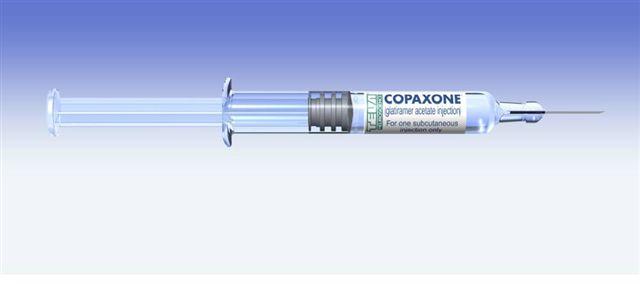The FDA approval was based on the positive results obtained in the clinical study and was given after a similar approval in February from the European equivalent

Teva announced today that the US Food and Drug Administration (FDA) approved an extended label for Copaxone. The expanded indication will now also include treatment of patients with a first clinical event (CIS - Clinically Isolated Syndrome) and exhibit magnetic resonance imaging (MRI) features that may indicate multiple sclerosis.
The FDA approval was based on the positive results obtained in the PreCISe clinical study, and was given after a similar approval from February 2009, by the Medicines and Healthcare Products Regulatory Authority (MHRA) jointly with the 24 countries of the European Union for an expanded indication for Copaxone that includes the treatment of patients after a first clinical event that may indicate multiple sclerosis.
Most patients with multiple sclerosis, up to about 85% of them, experience in the initial stages an isolated clinical event that may indicate multiple sclerosis. Scientific studies prove that early treatment of these patients may prevent or delay the risk of developing multiple sclerosis. With the approval of the extended indication in the USA and Europe, patients will be able to benefit from Copaxone already in the early stages of the disease.
"Copaxone, the world's leading drug for the treatment of multiple sclerosis, can provide therapeutic benefits already in the early stages - with the appearance of a first clinical event or in a patient with an MRI image typical of the disease," said Moshe Menor, senior vice president for the development of unique products of the Teva Group. "This milestone, in addition to the existing long-term safety and efficacy data, establishes Copaxone's status as a cornerstone in the treatment of multiple sclerosis."
FDA approval was given following the results of the PreCISe clinical study which demonstrated that Copaxone significantly reduced the risk of developing multiple sclerosis (24.7% compared to 42.9% in the placebo group). Among patients who finally developed another clinical attack, the time period was significantly extended (722 days compared to 336 days among placebo patients).
Copaxone is the only preparation for the treatment of relapsing-remitting multiple sclerosis (RRMS), which is supported by data from long-term prospective studies demonstrating that 8 out of 10 patients who persisted with Copaxone treatment are able to walk without assistance after 15 years of treatment and 22 years of illness on average.
Approval for an extended indication for Copaxone was given in December 2008 also in Australia by the health authorities (Therapeutic Goods Administration, TGA).
About the PreCISe study
The PreCISe study is a phase III, international, multicenter, prospective, double-blind, randomized study conducted in 80 centers worldwide. The study included 481 patients who underwent a single clinical event and presented MRI scans that may indicate multiple sclerosis. Patients included in the study were those who showed expression of unifocal disease (ie, clinical evidence of a single lesion). The patients received copaxone at a dose of 20 mg per day or alternatively a placebo by subcutaneous injection, and continued treatment during a period of up to three years, unless a second attack occurred which led to a diagnosis of clinically confirmed multiple sclerosis. Patients who were clinically diagnosed with multiple sclerosis continued to receive active treatment within the framework of the study during an additional two years. The main measure of effectiveness was the length of time to a clinically confirmed MS diagnosis, based on a second clinical attack.
Copaxone was also found to be well tolerated in the PreCISe study, with 84 percent of patients completing the treatment within the 3-year study; This is a rate similar to that observed in RRMS patients who were treated with Copaxone. All patients within the study participated in a follow-up study, which lasted up to five years, for the purpose of a prospective evaluation of the consequences of early Copaxone treatment, compared to Copaxone treatment at a more advanced stage, on the long-term course of the disease.
A pre-planned interim analysis was conducted on data accumulated from 81 percent of placebo-controlled exposure over 3 years. The results of the interim analysis, which were announced in December 2007, showed that the percentage of patients who developed clinically confirmed multiple sclerosis dropped from 43 percent in the placebo group to only 25 percent in the copaxone group (p< 0.0001). Also, the PreCISe study showed that the 25th percentile of the number of days to become clinically confirmed multiple sclerosis was prolonged by more than 2 times by the Copaxone treatment, from 336 days to 722 days (hazard ratio of 0.55, p=0.0005), compared to placebo .
Furthermore, in the MRI scans that were performed both after one and two years, a significant decrease in the number of new T2 lesions and in the number of T1 lesions was observed in the copaxone arm compared to the placebo arm.
In September 2008, additional MRI data from the PreCISe study were presented at the World Congress on Research and Treatment of Multiple Sclerosis (WCTRIMS) held in Montreal, Canada. The data showed that Copaxone treatment significantly reduced the activity of the disease manifested in MRI images, and improved the neuro-axonal condition in patients after a first clinical event that may indicate multiple sclerosis, compared to placebo patients. These results indicate for the first time neuro-axonal protection in patients who have undergone a first clinical event that may indicate multiple sclerosis.
About Copaxone
Copaxone (glatiramer acetate injection) is indicated to reduce the frequency of attacks in patients with relapsing-remitting multiple sclerosis (RRMS). The most common side effects of Copaxone are redness, pain, swelling, itching or a lump at the injection site, weakness, infection, nausea, joint pain, anxiety, and muscle stiffness.
The use of Copaxone is currently approved in 52 countries around the world, including the USA, Canada, Mexico, Australia, Israel and all European countries.

One response
In response, Teva shares rose by 0.43%